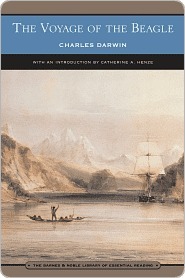More on this book
Community
Kindle Notes & Highlights
Structure and Distribution of Coral Reefs
Volcanic Islands visited during the Voyage of the Beagle
Geology of South ...
This highlight has been truncated due to consecutive passage length restrictions.
Geological Tran...
This highlight has been truncated due to consecutive passage length restrictions.
Devonport on the 27th of December, 1831.
1830--to survey the shores of Chile, Peru, and of some islands in the Pacific--and to carry a chain of chronometrical
6th of January we reached Teneriffe,
next morning we saw the sun rise behind the rugged outline of the...
This highlight has been truncated due to consecutive passage length restrictions.
Porto Praya,
When the island was discovered, the immediate neighbourhood of Porto Praya was clothed with trees,1 the reckless destruction of which has caused here, as at St. Helena, and at some of the Canary islands, almost entire sterility.
vintéms,
The hygrometer gave a difference of 29.6 degrees, between the temperature of the air,
infusoria,
harmattan
calcareous
friable
scoriaceous
arragonite.
Aplysia
Physalia,
galvanism,
St. Paul's. This cluster of rocks is situated in 0° 58' north latitude, and 29° 15' west longitude. It is 540 miles distant from the coast of America, and 350 from the island of Fernando Noronha.
cherty,
nulliporæ
cryptogamic
the booby and the noddy. The former is a species of gannet, and the latter a tern.
a fly (Olfersia) living on the booby, and a tick which must have come here as a parasite on the birds; a small brown moth, belonging to a genus that feeds on feathers; a beetle (Quedius) and a woodlouse from beneath the dung; and lastly, numerous spiders, which I suppose prey on these small attendants and scavengers of the waterfowl.
phonolite,
syenitic
plumbago.
ferruginous
Diodon Maculatus
Diodon antennatus,
The porcupine fish (as Diodon antennatus) is mentioned in Charles Darwin's famous account of his trip around the world The Voyage of the Beagle. He noted how the fish can swim quite fine when inflated even though the altered buoyancy requires it to do so upside down. Darwin also mentioned hearing from fellow naturalist "Dr. Allen of Forres, that he has frequently found a Diodon, floating alive and distended, in the stomach of the shark; and that on several occasions he has known it eat its way, not only through the coats of the stomach, but through the sides of the monster" (Voyage 14)
distending
found a Diodon, floating alive and distended, in the stomach of the shark; and that on several occasions he has known it eat its way, not only through the coats of the stomach, but through the sides of the monster, which has thus been killed.
Bahia.
(Trichodesmium erythraeum)
Captain Cook, in his third voyage, remarks that the sailors gave to this appearance the name of sea-sawdust.
septum,


